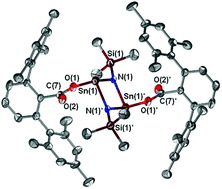Flexible coordination of the carboxylate ligand in tin(ii) amides and a 1,3-diaza-2,4-distannacyclobutanediyl†
Abstract
A series of tin(II) amido complexes possessing m-terphenyl carboxylate

* Corresponding authors
a Department of Chemistry, Simon Fraser University, Burnaby, BC, Canada
b
Department of Chemistry, Saint Mary's University, Halifax, NS, Canada
E-mail:
jason.clyburne@smu.ca
Tel: +1 902 420 5827
c Saskatchewan Structural Sciences Centre, University of Saskatchewan, Saskatoon, SK, Canada
d Department of Chemistry, University College of the Fraser Valley, Abbotsford, BC, Canada
e Department of Chemistry, University of Alberta, Edmonton, AB, Canada
A series of tin(II) amido complexes possessing m-terphenyl carboxylate

 Please wait while we load your content...
Something went wrong. Try again?
Please wait while we load your content...
Something went wrong. Try again?
D. A. Dickie, P. T. K. Lee, O. A. Labeodan, G. Schatte, N. Weinberg, A. R. Lewis, G. M. Bernard, R. E. Wasylishen and J. A. C. Clyburne, Dalton Trans., 2007, 2862 DOI: 10.1039/B704588C
To request permission to reproduce material from this article, please go to the Copyright Clearance Center request page.
If you are an author contributing to an RSC publication, you do not need to request permission provided correct acknowledgement is given.
If you are the author of this article, you do not need to request permission to reproduce figures and diagrams provided correct acknowledgement is given. If you want to reproduce the whole article in a third-party publication (excluding your thesis/dissertation for which permission is not required) please go to the Copyright Clearance Center request page.
Read more about how to correctly acknowledge RSC content.
 Fetching data from CrossRef.
Fetching data from CrossRef.
This may take some time to load.
Loading related content
